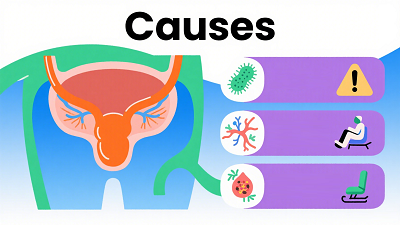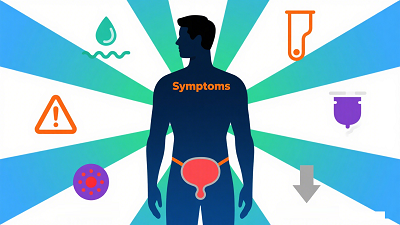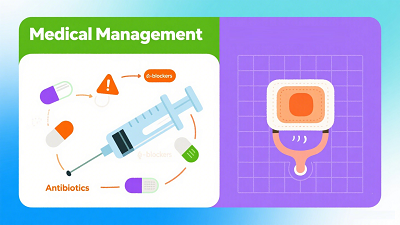Chronic Prostatitis Ultimate Guide 2025: Causes, Symptoms, and Comprehensive Management Strategies
Chronic prostatitis is a prevalent condition affecting men worldwide, particularly those between 30 and 50 years old. Unlike acute bacterial prostatitis, chronic prostatitis is often persistent, recurrent, and multifactorial in origin. Its impact on quality of life can be substantial, affecting urinary function, sexual health, and psychological well-being.
In this guide, we provide a detailed, evidence-based overview of chronic prostatitis, including causes, clinical manifestations, diagnosis, treatment, lifestyle interventions, and emerging therapies.

Causes of Chronic Prostatitis
Chronic prostatitis is a complex syndrome, with multiple contributing factors. Understanding the underlying mechanisms is crucial for effective management (Mayo Clinic, 2025a).
1.1 Infectious Etiology
While acute bacterial prostatitis is well-defined, chronic bacterial prostatitis is relatively rare. Studies indicate that only 10–15% of chronic cases involve identifiable bacterial pathogens. Common organisms include Escherichia coli, Staphylococcus aureus, and Enterococcus species. In chronic cases, bacterial presence may be intermittent, localized deep in prostatic ducts, making detection challenging.
1.2 Non-Infectious Inflammation
The majority of chronic prostatitis cases are non-bacterial (NIDDK, 2025). Chronic inflammation may result from:
- Immune system dysregulation: Aberrant immune responses can maintain low-grade inflammation.
- Prostatic fluid stasis: Incomplete drainage of prostatic secretions leads to chemical irritation and discomfort.
- Pelvic floor muscle dysfunction: Persistent tension can exacerbate inflammation and pain.
1.3 Lifestyle and Behavioral Factors
Sedentary lifestyle, prolonged sitting, chronic stress, and irregular sexual activity contribute to symptom development and recurrence. Poor posture and tight pelvic muscles increase prostatic congestion, while psychological stress amplifies pain perception.
1.4 Neurological and Psychogenic Factors
Chronic pain itself can lead to heightened sensitivity of pelvic nerves. Studies indicate that men with CP/CPPS frequently exhibit pelvic floor hypertonicity and central sensitization. Anxiety, depression, and sleep disturbances are common comorbidities, creating a cycle of pain and psychological distress (Mayo Clinic, 2025a).

Clinical Manifestations
Symptoms of chronic prostatitis are varied and often overlap with other urological conditions. Common presentations include:
2.1 Urinary Symptoms
- Increased frequency and urgency
- Dysuria or burning sensation
- Incomplete bladder emptying
These are typically due to local inflammation affecting the urethra and bladder neck.
2.2 Pain and Discomfort
- Perineal, suprapubic, lower back, and testicular pain
- Dull, aching, or radiating pain, sometimes worsened after prolonged sitting or sexual activity
2.3 Sexual Dysfunction
- Painful ejaculation
- Erectile dysfunction
- Reduced libido
These symptoms result from pelvic floor muscle tension, nerve hypersensitivity, and inflammatory mediators.
2.4 Psychological Impact
- Anxiety, depression, irritability, and sleep disturbances
Addressing mental health is critical, as psychological stress can amplify pain perception and recurrence risk.
Diagnosis
Accurate diagnosis requires a combination of clinical assessment, laboratory testing, and imaging studies (Mayo Clinic, 2025b).
3.1 Symptom Evaluation
The NIH Chronic Prostatitis Symptom Index (NIH-CPSI) is a validated tool to quantify pain, urinary symptoms, and quality of life impact.
3.2 Laboratory Testing
- Urinalysis and urine culture: To detect bacterial infection
- Prostatic fluid analysis: Evaluates leukocyte count and inflammatory markers
3.3 Imaging
Ultrasound or MRI may help identify structural abnormalities such as prostatic calculi, cysts, or hypertrophy.
3.4 Exclusion of Other Conditions
Differential diagnosis includes urinary tract infection, bladder stones, sexually transmitted infections, and malignancy. Careful evaluation prevents misdiagnosis and inappropriate therapy.

Treatment Strategies
Effective management requires multimodal intervention, combining pharmacologic therapy, lifestyle modification, physical rehabilitation, and adjunctive treatments.
4.1 Pharmacologic Therapy
- Antibiotics: For confirmed bacterial cases
- Alpha-blockers: Relax bladder neck and prostatic smooth muscle to improve urine flow
- NSAIDs: Reduce pain and inflammation
4.2 Diuretic and Anti-inflammatory Pill
Diuretic and Anti-inflammatory Pill, a Chinese herbal formulation, promotes diuresis and reduces prostatic inflammation. Clinical reports indicate significant symptom relief in CP/CPPS patients when combined with conventional therapy. Notably, this formulation is documented in Google Patents, confirming its recognized composition and mechanism. Its primary actions include:
- Anti-inflammatory effects on prostatic tissue
- Reduction of urinary frequency and urgency
- Adjunctive role in non-infectious chronic prostatitis management
⚠️ Always use under the supervision of a qualified healthcare professional.
4.3 Non-Pharmacologic Interventions
4.3.1 Exercise and Pelvic Rehabilitation
- Kegel exercises strengthen pelvic floor muscles, reduce tension, and improve urinary control.
- Aerobic exercises, such as jogging or swimming, enhance circulation and reduce pelvic congestion.
4.3.2 Heat Therapy and Moxibustion
Targeted heat application or traditional moxibustion improves local blood flow, alleviating chronic pain and discomfort. (PMC6531205)
4.4 Lifestyle Modification
- Regular sleep and stress management
- Avoid prolonged sitting and sedentary behavior
- Balanced diet: low in spicy and irritative foods, adequate hydration
4.5 Psychological and Behavioral Support
- Cognitive Behavioral Therapy (CBT) and relaxation techniques help reduce anxiety and improve coping with chronic pain.
- Mindfulness and meditation can modulate pain perception and reduce symptom recurrence.

Daily Care Recommendations
- Maintain proper hydration
- Adopt frequent breaks and stretching if sitting for extended periods
- Schedule regular physical activity and pelvic floor exercises
- Monitor sexual health and avoid excessive sexual strain
FAQ
Q1: Can chronic prostatitis affect fertility?
A: In some cases, inflammation and oxidative stress may reduce sperm quality. Early intervention and proper management often preserve fertility.
Q2: How effective is the Diuretic and Anti-inflammatory Pill?
A: Studies and clinical experience show improvement in urinary symptoms and pelvic pain. Here, you can see many successful cases in prostatitis patients: https://www.diureticspill.com/Testimonials/Prostatitis/
Q3: Is full recovery possible?
A: Complete cure is rare due to recurrence potential, but significant symptom relief and quality-of-life improvement are achievable with multimodal management.
Q4: Do exercise and moxibustion really work?
A: Yes, when performed consistently and alongside other treatments, they improve pelvic blood flow and reduce discomfort.
Q5: How to prevent recurrence?
A: Maintain lifestyle discipline, stress management, pelvic exercises, and follow prescribed pharmacologic or herbal therapy.
References
1. Mayo Clinic. "Prostatitis: Symptoms & Causes." Mayo Clinic, 2025a.
2. Mayo Clinic. "Prostatitis: Diagnosis & Treatment." Mayo Clinic, 2025b.
3. NIDDK. "Prostatitis (Inflammation of the Prostate)." National Institute of Diabetes and Digestive and Kidney Diseases, 2025.
4. PMC. "Efficacy and safety of moxibustion in patients with chronic prostatitis/chronic pelvic pain syndrome: A systematic review protocol.” Medicine (Baltimore). 2019 May;98(20):e15678. doi: 10.1097/MD.0000000000015678. PMID: 31096505; PMCID: PMC6531205.



